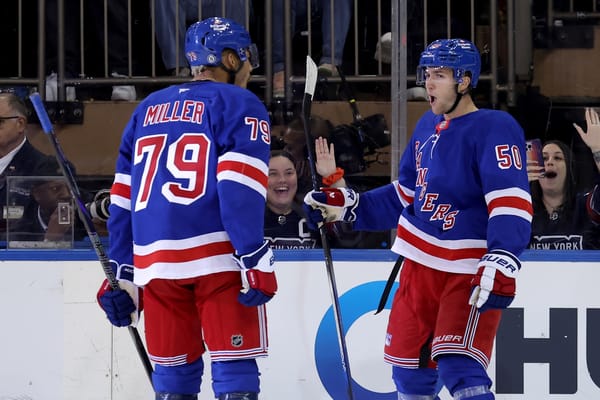2C or Not 2C? That is the Question
Arguably the biggest question surrounding the Rangers right now is who exactly is the team’s 2nd line center?
As we continue our wanderings through the dog days of the NHL offseason, there are still a number of questions surrounding the New York Rangers. Many are the same questions and arguments that have surrounded the team all offseason, like what to do with Chris Kreider, and some are newer, such as what the Rangers’ new third jersey should look like. One of the bigger questions though, that maybe hasn’t received enough attention, is what will the Rangers’ second line look like and who is going to center it?
The top line for the Blueshirts is pretty much set with wingers Artemi Panarin and Kaapo Kakko sandwiching Mika Zibanejad, as David Quinn alluded to after the Rangers drafted Kakko and signed Panarin. That leaves a whole bevy of options available for the bottom half of the top six.
As of right now, there looks to be three options to fill the two wing spots on the second line and they are Chris Kreider, Pavel Buchnevich, and Vitali Kravtsov. Again, this is all going off the assumption that Panarin and Kakko are on that top line which leaves Kreider as the 2LW and the two Russians (Buchnevich and Kravtsov) battling it out for the 2RW spot.
The biggest question about the second line, though, is who is going to be the pivot? Who is going to slot in between the wingers as they jump over the boards and onto the ice? Well, we’re gonna take a look at five main candidates for that second line role and see just how likely it is that they are the Rangers’ 2C on October 4th.
Let’s start with two players that kickstarted the Rangers’ future at the 2017 NHL Entry Draft; Lias Andersson (drafted 7th overall) and Filip Chytil (drafted 21st).
Both of Chytil and Andersson are coming into the 2019-20 season with something to prove, as Chytil looks to take a step forward in his development after a solid, if not spectacular, first full year in the NHL, and Andersson looks to just establish his NHL career after a rather fitful start to it. Of the two young centers, it’s Chytil who seems better positioned to jump into the 2C role after spending last season bouncing between the wing and center positions led to the young Czech putting up 11 goals and 23 points in 75 games. Over the course of the season, Chytil notably improved, especially as the season wore on and Filip’s ice time increased.
It’s hard to argue against elevating Chytil’s role to start this upcoming season. His most frequent linemates at 5-on-5 play last year, according to Corsica, were Chris Kreider and Kevin Hayes. Though the trio spent only 13 games together, they managed just under 84 minutes as a unit. With the additions made in the offseason, Chytil can now find himself playing next to talented wingers like Kravtsov, Buchnevich, and Kreider for long stretches of time, which can go a long way into cementing the young Czech forward’s role as the team’s 2C of the future.
On the flip side of Filip Chytil’s early post-draft success, as modest as it is, is Lias Andersson’s early post-draft career. Andersson was taken seventh overall by the Rangers in 2017, after trading then number one center Derek Stepan and backup goalie Antti Raanta to Arizona for the seventh overall pick and defenseman Tony DeAngelo.
Seen as the first step in a rebuild, Andersson was touted as being NHL-ready from the draft floor and those factors have led to some outsized expectations placed upon the young Swede. As much as Chytil can use this upcoming season to cement himself as a top six forward, Lias needs to use this season to cement himself as a NHL-caliber player, or at least it feels that way.
After picking up only 6 points in 42 games last season, one spent between Hartford and New York, one way for Andersson to quiet all the rumblings and doubts is to grab that 2C position by the horns and never let go of it. It might sound extreme for someone who hasn’t been able to secure a NHL spot to be in position for a second line center role, but the Rangers don’t have many choices and if the team is committed to their young players, this is a way to show some of that faith. Essentially, try it until it’s clear it doesn’t work.
Like Chytil, Andersson would definitely benefit from the upgrade in linemates the second line pivot brings with it. Needless to say, and no disrespect intended, but Connor Brickley and Boo Nieves are not really Chris Kreider or Vitali Kravtsov. Having two legitimate top six wingers can allow Andersson a chance to relax a bit and rely on his forwards to help ease burden of the role, which can in turn allow Lias to find his game and elevate it to where the organization intends it to be.
When the Rangers traded Ryan Spooner to the Oilers for Ryan Strome last November, no one really expected much of anything from the former fifth overall pick. The Rangers were swapping one player that had become a shell of his former self for another, and that was that. Then Strome decided to score almost at-will as the season wore on, ending with an almost absurd 18 goals and 33 points in 63 games after scoring once in 18 games with the Oilers. This doesn’t hide the fact that underneath the scoring, Ryan Strome was very not good for the Rangers last year and was bolstered by an insane shooting percentage (22%, as a career 10% shooter!).
Strome does have some physical qualities that make him appealing to those who are dazzled by the red flashing lights behind the opposing team’s nets — primarily that he’s a right handed shot on a team that doesn’t have many righties up front.
Now Ryan Strome as the 2C should only be seen as a nuclear option of sorts. In case things go sideways (injuries, sudden dragon attack) the Rangers can insert Strome in that slot as another veteran pivot to help the Rangers’ young wingers get acclimated to the NHL. By no means should he be the first option the Rangers go to in that role, but if Chytil or Andersson don’t step up right away or need some more time, then Strome is there to act as a stopgap. Also, playing Strome on the second line can help boost his trade value come the trade deadline so pumping and dumping him by late February is always a possibility.
There are two other options that have been thrown around in the Rangers’ social media sphere for that #2 slot, but I don’t think they are legitimate options — at least, not right away. The ideas going around are to start either Kakko or Kravtsov at center and I think both would be very bad ideas. Outside of one tournament, Kravtsov has not played center much at all. The only reason he was Russia’s 1C at the World Juniors was because of an injury. He’s played almost all of his time with Traktor in the KHL as a right winger and moving him to the middle at the start of his first season in North America is a good way to really hamper his development. As for Kakko, the idea of moving him out of his natural position, a position out of which he absolutely dominated, to begin his NHL career seems foolhardy at best.
Talk about suffering the slings and arrows of outrageous fortune.




